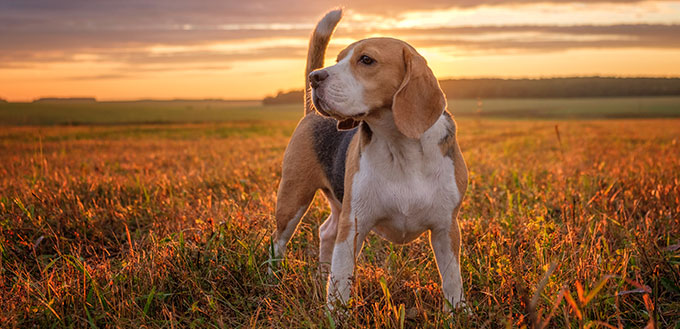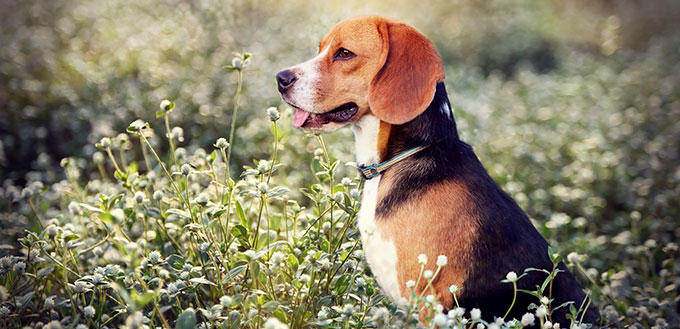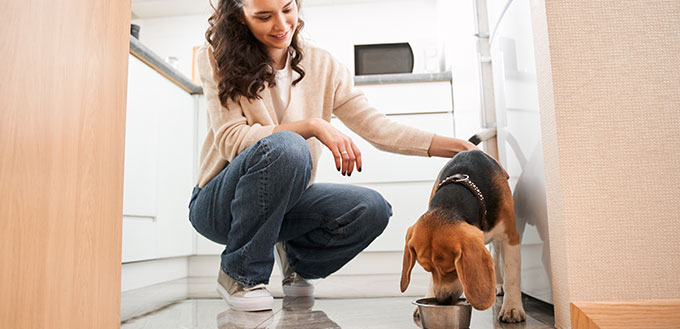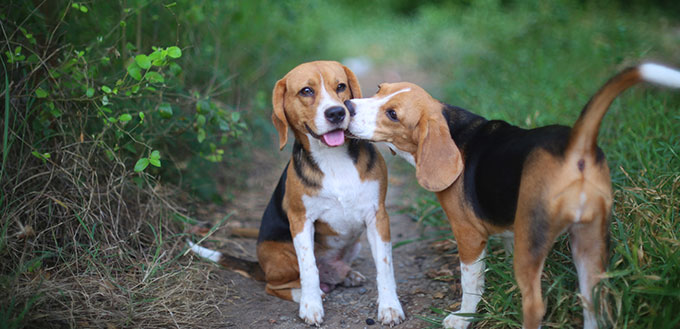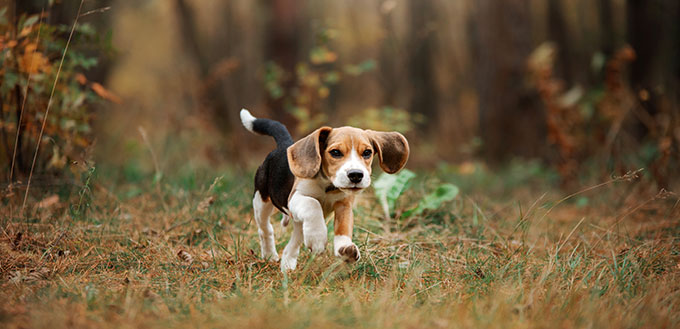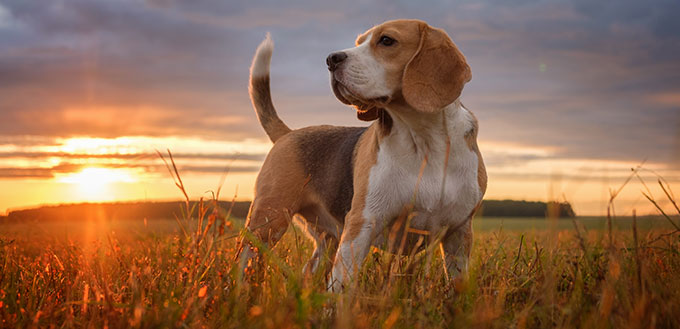New pet parents should always do whatever they can to prepare themselves for their new arrival. If you’re thinking of getting a Beagle, then lucky for you there is a wealth of information available about them! We have put together a comprehensive guide to Beagles, and how best to prepare for your new hound dog, from feeding and grooming to personality traits and expenses.
Breed Overview
| Dog Breed Group | Height | Weight | Life Expectancy | Energy Level |
|---|---|---|---|---|
| Hound Dogs | 13-15 inches | 18-30 pounds | 12-15 years | Moderate |
History of the Beagle
The Beagle dog breeds history is thought to go back as far as the 16th century in England. Englishman would own packs of hounds used for rabbit hunting as well as other small prey. These hound packs would also be used as gun dogs and would flush out games for the hunters to shoot.
The breed’s development originated in England and later moved over to North America when the first Beagle was imported from England in the early 1870s. where the Beagle became more widely recognized and refined by the late 19th century and was eventually recognized by the American Kennel Club, otherwise known as the AKC, in 1885. History has shown the Beagle to be a spectacular hunting dog, a reputation that they still uphold today.
The Association of Masters of Harriers and Beagles and the Beagle Club were founded in 1891 and 1890.
Beagles are used by the United States Department of Agriculture as a way of detecting contraband food items that have been stored away in luggage, this is due to them being scent hounds, putting them in ranks with Bloodhounds and basset hounds with their keep sense of smell.
Early development stages of the Beagle resulted in a Beagle small enough to fit into your pocket, standing only 8-9 inches tall, otherwise known as “Pocket Beagles”. The life expectancy of a pocket Beagle was no different than that of a modern-day Beagle, and these tiny pooches were still used for rabbit hunting as they were small, nimble, and quick on their feet. They may have only been small dogs, but these smaller hounds were extremely good at their hunting job, and the Beagle size only changed as demand shifted to large hunting dogs instead.
Breed Highlights
- Beagles are often targeted by thieves with the intent of stealing them and selling them on either for experimentation And research. It is extremely important that a Beagle be microchipped for this reason.
- Beagles are notoriously difficult dogs to housetrain.
- Beagles have the nickname of being “chowhounds”, which means that they will over-eat if given the opportunity.
- Beagles can also be very stubborn dogs and require plenty of obedience training early in life.
- Many Beagles end up being given up to shelters as a result of their owners being unaware of how often they Bay and not knowing how to control it.
Breed Appearance
Beagles are regal, friendly-faced, beautiful scent hounds, with a good reason for being so well-loved all over America, and there are many key characteristics to the Beagle dog breeds appearance that define the breed. If you are wanting a show quality Beagle or one of a purer lineage, familiarizing yourself with the aesthetic traits can help you to know the breed better.
Size
| Measurement | Male | Female |
|---|---|---|
| Height (to top of head) | 19-22 inches | 18-20 inches |
| Withers Height | 14-16 inches | 13-15 inches |
| Length | 22-25 inches | 20-24 inches |
| Weight | 22-24 pounds | 20-22 pounds |
Coat
| Feature | Description |
|---|---|
| Hound Color | hound colors include two varieties - white, black and tan or blue, white and tan (less commonly, red and white) |
| Length | Short coats |
| Texture | Smooth dense fur |
| Pattern | Beagles should be expected to have a white tip to their tail, white feet, a white chest and a white face, with the rest being tan except for a large area of black across their back |
| Resistance | Weather-resistance outer layer of fur and thick soft undercoat for warmth. |
| Thickness | Very dense coats |
Face
| Feature | Feature Description |
|---|---|
| Eyes | Dark brown or hazel |
| Nose | Always black |
| Muzzle | White with sagging jowls |
| Ears | Wide, long, and floppy ears |
| Head | Rectangular, slightly domed, long, and narrow, with the ears adding extra width. |
Build
| Feature | Description |
|---|---|
| Mass | Very muscular with little body fat (with the correct diet and exercise). |
| Overall Size | Medium stature for easy movement through underbrush when hunting. |
| Body Shape | Squared body, with a broad chest. |
| Legs | Shorter at the front, longer at the back, to help propel themselves forward. |
| Additional Features | A relatively short muscular tails, and wide spread toes for extra balance and security. |
Interesting Beagle Facts
- Snoopy the dog, from the comic strip “Peanuts”, and best buddy of Charlie Brown, is also a Beagle!
- A Beagle by the name of “Purin” made the Guinness World Record for “The Fastest 10 meters traveled on a ball by a dog”, done in 9.45 seconds.
- Beagles have around 220 million scent receptors on their noses! (humans only have around 5 million)
- Beagles are considered the best tracking dogs in the world.
- The ears actually help them to hold scents closer to the nose for longer, so scooping up the scented air as they walk.
- A Beagle called Elvis in Denver Zoo is used to detect whether their resident polar bear is pregnant by sniffing her poop!
- Vice President Lyndon B Johnson had a Beagle that went by the name “Beagle”.
- “Uno” was the first Beagle to win the Westminster Kennel Club Dog Show in 2008.
- Queen Elizabeth I often entertained guests at her royal table by allowing her Pocket Beagles to cavort amid their cups and plates.
The Beagle Dog Breed Personality
The personality of a Beagle is that of a boisterous toddler a lot of the time! They are a loud, excitable, playful, and loveable breed. They are an extremely friendly breed that makes a fantastic family companion, as family dogs, they become extremely attached to their human pack as well as being loyal to a fault. Generally speaking, Beagles are very good with unfamiliar humans and other animals so long as they are socialized properly from an early age, though considering they were used as rabbit hunters, they may enjoy chasing smaller pets if they’re not trained against it as puppies.
When it comes to temperament, Beagles have become gentler dogs with time, since their early, more ruthless, hunter routes.
They are wonderfully sociable companions and because of their loveable personality Beagles are easy to introduce to new people. And because they are pack hounds, they enjoy a big family that is preferably present for most of the day, as they can struggle with separation anxiety if they’re left alone for too long and may become destructive as a result.
Dog walkers need to be aware that your dog cannot come off the leash because Beagles are known to be escape artists when they’ve sniffed something interesting on the air. Hunting is in their nature, even if they’re just hunting an old burger in the trash can nearby.
Quick Personality Facts
- Beagles get along really well with children and other pets.
- They can be anxious when left alone for long periods of time.
- Because they are pack-hunting dogs, they have a natural ability to get along with other dogs.
- Beagle puppies can be hyperactive and unfocused making them difficult to housetrain.
- A Beagles nose can distract them from a task, or turn them into escape artists!
Beagle Care
Figuring out how best to care for your new Beagle can be quite daunting, just as it is looking after any living creature. However, so long as you have made the effort to research the breed beforehand and familiarize yourself with the key elements of Beagle care you can be sure that you have done everything possible to give them a good home.
Training
Even though they are a highly intelligent breed that is eager to please, Beagles are notoriously difficult to train. The key to training a Beagle successfully is patients; you might find that they go off track, so you just need to find the best way to bring them back to the matter at hand. Positive reinforcement is always a great way to go, and something that Beagles are known to respond well to.
Why are Beagles Difficult to Train?
Beagles are bred as hunting hounds, which means they are particularly adept at finding and flushing out prey when on the hunt. The problem is that because they have been bred this way, their hunting instincts are extremely powerful and can take over; they struggle to stay put or stay focused, especially if they catch an interesting scent on the wind.
Beagles are inquisitive by nature, as well as being extremely driven towards their goal, though they may not have the same goal as their trainer. When doing basic obedience training with your Beagle they need to remain on the leash at all times and have plenty of positive reinforcement whenever they respond well to instruction.
Potty Training
Because of their lack of attention span whilst they are young, you may find your new canine companion difficult to potty train. The key things to remember however are; not to scold them when they have an accident but to be firm and assertive, to reward them when they use their puppy pad or go outside, and to watch them closely for any signs that they may wish to relieve themself if so, quickly put them on a leash and take them outside.
Obedience Training
Some of the most important commands to teach your Beagle are “hush”, “sit”, “come”, and “heel”. These basic obedience commands can make the remainder of your Beagle’s upbringing much easier for yourself and your dog; “hush” is particularly important as Beagles are very vocal dogs that need to be taught when to be quiet.
Work
If you’re providing your Beagle buddy with a working home you can be sure that once their basic training is down they will work brilliantly for you. They are determined, eager to please, extremely loyal, and intelligent. Once you have been able to fine-tune their reaction to commands, you’ll find that they are a very responsive dog that can make excellent working and hunting companions.
Feeding
Like many dogs, there are several diet options for a Beagle. You could choose between a raw dog food diet, dry kibble, or wet dog food. The main thing to keep in mind when trying to decide how best to feed your Beagle is that this particular breed is susceptible to excessive weight gain, so it is key to ensure they are eating the right amount of dog food and are limited on their snacks and treats.
You May Also Like: Dog Food for Beagles
Raw Dog Food
Raw feed diets are rapidly growing in popularity, and use raw meat, vegetables, eggshells, and whole bones, just as you would expect them to eat in the wild. We have to remember that all dogs were once wild and gradually domesticated with time, so raw food items cater to their natural instinct, though it is generally a more costly option. Your dog’s general health can also massively benefit from this diet.
Biscuits / Dry Kibble
A kibble diet can suit anybody from a low budget to a high budget as there is a very wide range of good-quality kibble food on the market. The most important thing is to make sure that you do your research into the kibble you are thinking of using and ensure that they are not using too many fillers, or bulking agents.
Because Beagles are working dogs, they require plenty of protein in their food to help their muscles to recover after a long day’s work. You must also be sure to avoid dog food that is too high in fat, as Beagles can gain weight easily if their diet is not monitored carefully. Kibble that provides a good balance of protein, carbohydrates, and healthy fats whilst avoiding the use of by-products, preservatives, and bulking agents is the ideal food for any Beagle.
Wet Dog Food
Any dog would have to be mad to pass up a wet dog food diet option; it is delicious and chock-full of gravy and plenty of soft protein to keep them content, however wet food does come with its own set of risks regarding weight gain and dental hygiene which needs to be considered.
Many wet foods are often very high in fat and at the cheaper end can also contain sugar, which as you can imagine it’s not great for your dog’s dental hygiene. Dry foods can help to keep your dog’s teeth clean (though brushing is always necessary), whereas wet food does not provide that abrasive quality that dry food can give.
Do Beagles Drink a Lot of Water?
An average 30 pound Beagle should drink around 30 to 60 ounces, or 4 to 7.5 cups, of water per day. A pregnant Beagle may drink a little bit more than usual, but it should not be a noticeable difference. If you are noticing that your Beagle seems to be drinking significantly more than they ordinarily would, for example going from one bowl to two-three per day, it could be a sign of diabetes, kidney or liver disease, a urinary tract infection, or uterine infection and so it is best to approach your vet immediately for further advice. Your vet will be able to carry out some tests to try and figure out the source of the problem.
Be Careful With Their Weight
Beagles are a well-known breed for struggling with excessive weight gain as they get older, it is important that as you feed your Beagle you are sure to stick to the recommended portion sizes and keep their snacking and treats to a minimum, or swap out your standard treats for something much healthier, like a carrot.
Grooming
Beagles have a lush short medium-length coat that is thick, meaning they have plenty of fur to drop. Because they are working dogs they have a double coat, meaning there is a second layer to help to keep them warm in cold weather; the undercoat insulation the body and is dense and fluffy, where the topcoat provides a weather-resistant layer to help them to shield against wind, rain, and sun. This does mean that Beagle will shed a lot throughout the year, and particularly more so during the two shedding seasons (spring and winter).
Managing Shedding
Due to the constant shedding, it would be wise of you to prepare for your new puppy by getting together some de-shedding products, such as de-shedding shampoos and conditioners, as well as a good de-shedding brush. Ideally, you want to brush your Beagle every few days and give yourself about 15-minutes to get the job done thoroughly. This can also be used as a bonding period between you and your pup!
Bath Time
Beagles have a rather fun habit of rolling around in anything that they like the smell of! As you can imagine this isn’t the most pleasant thing it’s to have to deal with and results in them needing quite a few more baths than the average dog, so nicely scented dog washes are a must.
Health
Beagles are generally considered one of the healthier dog breeds, with an average life span of 12-15 years. though, like any dog, or any human for that matter, Beagles have certain health conditions that they can be susceptible to, as well as developing general health problems that can affect most dogs. Listed in the table below are all of the potential health problems your Beagle could experience throughout its life. Don’t let it panic you though! There is every possibility that your Beagle could go its entire life without a single one of these issues affecting them.
- Ear Hematomas: Ear hematomas are characterized by swelling of the ear flap and are the accumulation of blood in the pinna of the ear. It’s a condition caused by blood vessels bursting and bleeding into the space between the cartilage and the skin. This is most commonly seen in dogs with floppy ears, as it can be triggered by trauma like shaking of the head or excessive scratching; regular ear infections are often a trigger for excessive scratching. This condition often resolves itself, though if it is particularly bad you can approach your vet about having it drained to help aid the healing process.
- Hip Dysplasia: Hip dysplasia is the result of a hereditary condition, this condition affects the thigh bone and the way that fits into the hip joint. Hip Dysplasia is painful and results in lameness, or potentially an inability to walk in the most severe cases. It most commonly affects senior dogs, however, there are signs that can be spotted by a veterinarian whilst they are still puppies. Hip Dysplasia can also be triggered by injury or rapid growth due to a high-calorie intake. There are treatments and veterinary medicine available which would be ideal for helping your dog to navigate their day-to-day life and deal with the pain, and if needs be there are surgeries that can help to rectify the problem though this may not always be the perfect solution.
- Luxating Patella: Luxating Patella is a condition that causes loose knees and knee dysplasia, much like Hip Dysplasia, it is a painful condition that can result in lameness and causes joint laxity. There are medications and treatments available that may help your dog to deal with any discomfort or pain that they may be experiencing, but unfortunately, there are no preventative medications, easy fixes, or cures for this condition.
- Epilepsy: Epilepsy is a term that covers several afflictions, such as seizures, reactive seizures, fits, and convulsions. Epilepsy is believed to be inherited and so if you adopt a breed that has a high risk of fitting it is best to watch them carefully for any indication that your dog may suffer with them. Also be sure to speak with your veterinarian, who will be able to advise you on ways to prepare for and deal with a seizure, should one occur. Seizures are a serious concern with Beagles, and the key thing to remember is to stay calm should a seizure happen, and remember the advice given to you.
- Inherited Deafness: Beagles can inherit deafness, and it is usually easy to recognize which Beagle could become deaf by their coat color, particularly if they have a lot of white on their head.
It may seem like a lot, but Beagles are known for not really suffering from many health issues, though it doesn’t hurt to be informed, especially if this is your first Beagle.
Exercising
When it comes to the exercise needs of a Beagle whilst they are young, they would benefit from a minimum of 30-minutes a day, however, it is best to aim for an hour to an hour and a half where possible. Of course, as they get older you may well find that they are slightly less interested in exercise as they get past the age that they will be expected to hunt, which will likely be around 8 to 10 years of age as they approach seniority, so be sure to keep up with their exercise needs until then!
Due to Beagles being hunting hounds they have an almost endless supply of energy and their powerful sense of smell will lead them on a trail for hours if given the opportunity. Because of these breed characteristics, they are able to continue walking all day without becoming tired, and so they are perfectly suited to anybody who lives an active lifestyle, someone who is willing to regularly take them for long walks around the dog park. They’d especially do well with anyone that enjoys the more physically demanding activities such as hiking, and would even benefit from dog sports such as agility training.
Adopt Don’t Shop
Unfortunately, the sad reality for a lot of Beagles is that their new owners are not able to handle their boisterous personalities and vocalization, And as a result, many beagles find themselves in shelters rather than their owners taking the time to train them correctly. buying a new puppy only encourages readers to continue reading but dog when there are already so many without homes waiting for the perfect family. Wherever possible it is always best to seriously consider providing a home for a puppy that has lost theirs, And helping their dream of a loving family become a reality.
Beagle Rescue
There are many great Beagle-specific rescue groups throughout America that can provide you with the perfect Beagle for your home, as well as filling your new puppy’s life with the love, care, and attention that it deserves. Here are just a few examples of the rescue groups available for Beagle rehoming.
American Beagle Relief Network – Based in Texas, rehoming Beagles throughout America.
Midwest Beagle Rescue, Education & Welfare – Based in the Midwest, rehoming Beagles in Western Pennsylvania, Ohio, Michigan, Indiana, Illinois, and Wisconsin, as well as adopting out to Minnesota, Iowa, and Missouri.
California Beagle Rescue -Based in California, rehoming Beagles throughout America.
Beagle Rescue League – Based in Bucks County, Pennsylvania, rehoming the Beagles of Eastern Pennsylvania, New Jersey, and the surrounding counties.
You can also speak with your local animal shelter for advice on where to adopt a Beagle from, or research where you may find a relatively local Beagle rescue.
Reputable Breeders
Finding a reputable breeder is never easy, but it is always best to take the time to try and find the best source for your Beagle puppy. The safest way to guarantee that you are finding yourself a good breeder would be to look through the AKC marketplace, or contact the National Beagle Club for information regarding breeders.
You can also find A reputable breeder by referral, this is me speaking with your veterinarian or perhaps a trusted friend that also has a beagle. You could also contact your local Beagle club or visit professional dog shows, and make connections with the appropriate people that may be able to help you to find a Beagle puppy of your own.
Price
Beagle puppies tend to cost anywhere between $400 and $1,000, there are certain variations of the Breed which may be worth more, for example, Lemon Beagles known for their tan and white color are considered to be rarer than the Tricolor variation and can cost between $500 and $1,300.
Becoming more expensive still, if you are able to find a Beagle that comes from a purebred lineage and a reputable breeder you are looking at the potential cost of up to $5,000, Particularly they are AKC registered.
Alternatively, vehicles can be adopted from shelters for as low as $200, which gives you a little bit more money to prepare for their arrival.
Additional Expenses
Not only do you need to look at the cost of buying the Beagle itself you also need to look at the additional pet care expenses such as dog license fees, which can range between $10-$20 for fixed pets, or $20-$50 for unspayed or unneutered pets. Though some areas don’t require a dog license at all. Additionally, the following preparations and considerations should be made:
- Toys and training equipment
- A collar and ID tag
- Microchipping
- A crate (if wanted)
- Food and water bowls
- Monthly food cost
- Monthly supplement cost (if needed)
- Pet health insurance
- Medical care
- Treats
- Grooming
- General pet care
- Beagle club (if wanted)
Planning your pet care expenses ahead of time can save you a lot of hassle in the future, and help you to feel better prepared for your new puppy pal.
FAQ’s:
Q: Who should get a Beagle dog?
A: Beagles, being scent hounds, would be well placed with an owner that would make use of their scenthound abilities, such as a hunter. Beagles require an owner that is willing to work hard with them, provide them with plenty of exercise, and be willing to play on demand. Though Beagles are kept in a wide variety of homes, they are best suggested to be kept by an owner that can provide them with plenty of space, stimulation, and even work if possible to keep their minds active.
Q: Is a Beagle a good first dog?
A: So long as you do your research and know what to expect, a Beagle can be a fantastic first-time dog. Though they are one of the more stubborn dog breeds, with the correct training they are easy enough to handle. They are gentle, friendly, loving, and playful dogs that have a proclivity towards being extremely loyal to their family. The only thing to keep in mind if you’re thinking of having a Beagle as your first dog is that they require plenty of exercise, both mental and physical as they have an extremely high energy level.
Q: Are Beagles high maintenance?
A: In terms of grooming and general care, the Beagle dog breed is actually very low maintenance; their short coats don’t require much brushing, though their tendency to roll in interesting smelling things does mean they require more baths. But their requirement but plenty of exercise and committed training does mean that maintaining a sufficient level of stimulation may be more demanding than you’d think.
Q: Are Beagles good family dogs?
A: Beagles are one of the more friendly, loyal, loving, playful, and obedient dog breeds and one of the more popular breeds in America for families as well as workers. They are excellent with children, though as it is with any dog you must always be sure to teach your child how best to handle their canine pal so that your pup doesn’t feel mistreated. They also struggle with being left alone and do best with an active family, all in all, they make great family dogs.
Q: Do Beagles like to cuddle?
A: As lively a breed as they may be, Beagles will always make time for a good cuddle at the end of the day. In fact, Beagles are extremely affectionate and have a tendency to seek their owner’s attention a lot of the time, which can be challenging for a busy owner, but know that they only do it because they love you so much. They adore their family and will always want to stay close, so rest assured that your pup will always enjoy a hug if you’re giving them out.
Q. Are Fox Hounds and Beagles the same?
A: Though they share the same ancestry and look very much alike, the Fox Hound and Beagle or not the same breed. Beagles are actually smaller hounds, where the Fox Hound stands an average of eight inches taller than them. Foxhounds are currently the more preferred breed for hunting as they are predominantly used for larger game, whereas the beagle is for small game. The beagle now, more often than not, finds itself in family homes because of its friendliness and loveable breed traits.
Sources:
- Meredith Hooker Williams, 5 Reasons a Beagle Might Be the Right Dog Breed for You, Vetstreet
- Beagle Traits, VCA


